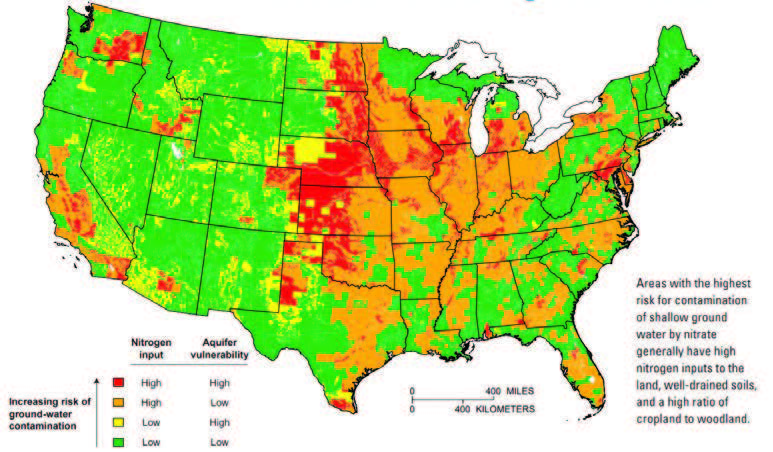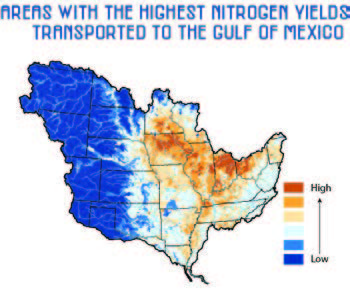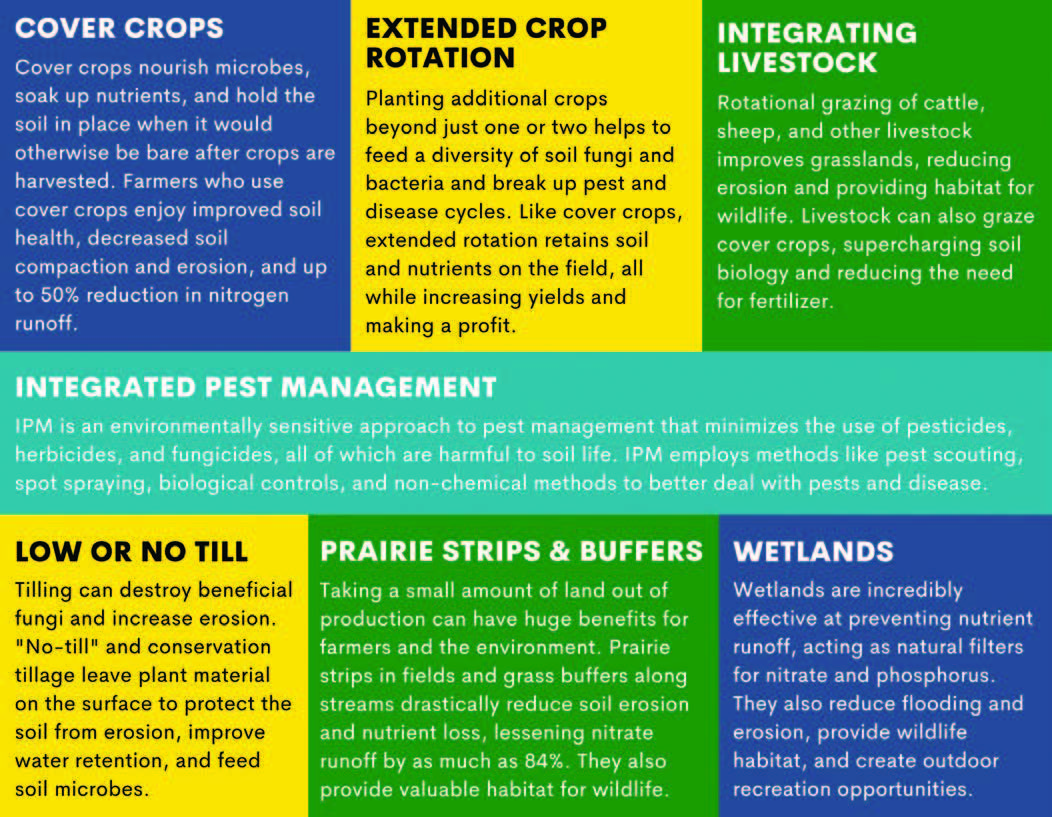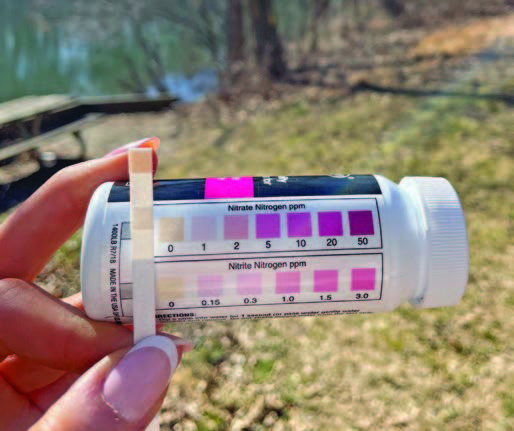It’s hard to believe. We know that nitrogen running off agricultural lands, leaking from septic systems and draining out of wastewater treatment plants delivers excess nitrate to waterways. The damaging effects of this pollutant on human health
and the environment are well-documented and understood.
Nitrate in drinking water contributes to cancer and infant mortality. Nitrogen pollution causes a massive dead zone in the Gulf of Mexico and billions of dollars in economic harm.
Yet, every year we apply millions of tons of nitrogen to land across the U.S.
Solutions are available. So how can we implement them on a national scale? And just how widespread is the pollution?
To help tackle these two critical questions, the Izaak Walton League has launched a volunteer water monitoring program called Nitrate Watch. First, some background about this growing problem.
What is nitrate, where does it come from?
Nitrate (NO3
-) is a naturally occurring compound made up of nitrogen and oxygen. Nitrogen is an essential nutrient for plants – it is found in enzymes and proteins and is a key component of chlorophyll molecules.
Striving to produce greater yields and grow food in soil lacking natural nutrients, modern agriculture applies more nitrogen than soil can absorb. Manure and sewage also add nitrogen to the landscape.
As this nutrient moves through the environment, it interacts with nitrifying bacteria and becomes nitrate. Nitrate is soluble in water, which means that it is easily carried off the land by rainwater, irrigation systems or melting snow. Through surface
runoff or groundwater saturation, nitrate frequently makes its way to streams, lakes and our sources of drinking water.
This is where problems arise.

Human harms
For decades, we have known that consuming water with elevated nitrate levels is harmful to human health. Ingesting water with an abundance of nitrate can interfere with our blood’s ability to transport oxygen. In infants younger than six months,
that can lead to a condition called methemoglobinemia (or “blue baby syndrome”), which can cause the skin to turn blueish-gray and may lead to serious illness or death.
In 1992, in an attempt to combat blue baby syndrome, the U.S. Environmental Protection Agency placed a limit on the amount of nitrate allowable in drinking water. This limit was set at 10 parts per million (ppm), which is equivalent to 10 milligrams of
nitrate per liter of water (mg/L). This regulatory standard has not been updated since it was set in 1992 – more than a generation ago.
Colorectal cancer, thyroid disease, and neural tube birth defects (like spina bifida and anencephaly) were all linked to drinking water contaminated with nitrate.
Unfortunately, blue baby syndrome is not the only health impact associated with nitrate consumption. Colorectal cancer, thyroid disease, and neural tube birth defects (like spina bifida and anencephaly, a serious birth defect in which a baby is born without
parts of the brain and skull) are all linked to drinking water contaminated with nitrate. This is the conclusion of a 2018 analysis of 30 studies on the effects of nitrate consumption on human health published in the International Journal of Environmental Research and Public Health.
The authors of that analysis state that “many studies observed increased risk with ingestion of water nitrate levels that were below regulatory limits,” especially with prolonged exposure to nitrate in drinking water. These findings raise
serious questions about whether the 30-year-old EPA standard adequately protects public health. This article notes the need for additional studies to further our understanding of the health effects of nitrate consumption.
Well water?
The type of water system used to supply a person’s drinking water can influence how much nitrate they are exposed to. Public drinking water systems draw from surface water, groundwater, or both, and are subject to regulatory limits set forth by
the EPA and local government agencies. This means that municipalities and drinking water utilities must filter out any nitrate above 10 mg/L.
Private wells draw exclusively from groundwater sources and are not subject to regulations for contaminants, including nitrate. A 2018 study of water use in the United States by the US Geological Survey reported that approximately 42.5 million Americans
(13 percent of the total population) had self-supplied water at their homes. Over 98 percent of these people obtained their water from a private groundwater well.
Communities at greatest risk of exposure are those located in agricultural regions that obtain their water from shallow wells. Water in these areas often has increased nitrate pollution resulting from fertilizer applied to farmlands and waste from animal
feeding operations.
The Iowa Rural Drinking Water Survey studied the risk of exposure to nitrate in drinking water in rural Iowa. This study, conducted by Iowa State University’s Center for Agricultural and Rural Development in 2022, surveyed over 8,000 rural homes
and found that one third of surveyed households are at high risk of nitrate exposure due to lack of testing, filtering or bottled water use.
The study also asked rural Iowans for their perception of water quality issues in their community and statewide. About 40 percent of respondents indicated that they were concerned about the presence of nitrate in drinking water, but fewer than 25 percent
believed that it was an issue in their local area. This relatively low concern for local water quality in areas vulnerable to dangerous nitrate levels means that better awareness about this issue is important.
 The Mississippi river watershed drains states where high amounts of nitrogen are applied to farms.
The Mississippi river watershed drains states where high amounts of nitrogen are applied to farms.Environmental harms
Plants need nitrogen to grow. But too much of a good thing can be a very bad thing.
When waterways receive an influx of nitrate pollution via runoff or groundwater saturation, a cascade of harmful ecological effects is set in motion. First, the increased available nitrogen is taken up by aquatic plants, especially algae. Algae grow very
quickly when excess nutrients are available, but each alga is relatively short-lived. Ultimately, the result is a large amount of dead and decaying algae, which block out sunlight lower in the water column and increase the water temperature.
The process of decomposition consumes oxygen, resulting in hypoxic areas (areas low in dissolved oxygen). Under hypoxic conditions, many aquatic species, including fish and macroinvertebrates, find it hard to survive. The result – fish kills and
dead zones.
Where the Mississippi River empties into the Gulf of Mexico, off the coast of Louisiana, provides the best-known example of a dead zone for aquatic life. Corn belt states in the Mississippi watershed like Illinois, Iowa and Indiana bear responsibility
for a large portion of the nutrient pollution that has contributed to this dead zone (see map above).
Algal blooms
Algal blooms can harbor toxic cyanobacteria, making them even more harmful to humans and the environment.
In some cases, algal blooms can harbor toxic cyanobacteria, making them even more harmful to humans and the environment. Some types of cyanobacteria, also called “blue-green algae,” thrive under the same nutrient-enriched conditions that create
algae blooms. These cyanobacteria create compounds called “cyanotoxins” which can be dangerous to humans or animals that come into contact with them.
Probably the most familiar type of cyanotoxins are the microcystins, which pose a serious threat to human and animal health worldwide. Drinking, touching or even inhaling water containing microcystins can cause severe health problems. Symptoms of microcystin
poisoning include weakness, stomach pains, nausea, labored breathing, muscle tremors, vomiting and diarrhea. Exposure to microcystins can lead to coma and even death. When beaches and waterways are closed to swimming in the summer, microcystin from
blue-green algae is often to blame.
Economic harms
Beyond the obvious value of human health and environmental quality, what is the cost of nitrate pollution?
Nitrate pollution has far-reaching effects on the economy, impacting a wide range of industries. Algal blooms are unsightly and potentially dangerous, but they can also drag down recreational spending and property values. In Iowa, this impact has been
quantified. A 2018 Iowa State study found that reducing nitrate pollution by 45 percent would deliver $30 million annually in recreational benefits to Iowans.
Algae blooms harboring toxic cyanobacteria can contaminate fish and shellfish, harming that sector. According to the EPA, the fishing industry loses tens of millions of dollars of revenue every year due to nutrient pollution.
It is also worth considering the medical costs of nitrate pollution. A case study published in 2020 found that the people of Wisconsin collectively pay between $23 million and $80 million each year in medical expenses associated with drinking water contaminated
with nitrate. Nationally, cancer cases attributable to nitrate pollution carry an economic impact of $250 million to $1.5 billion in medical costs alone, with a potential of $1.3 to $6.5 billion in lost productivity, according to a 2019 study by researchers
at the Environmental Working Group and Duke University.
Removing nitrate from drinking water
 Preventing movement of nitrates from crops to streams is the focus of ARS soil microbiologist Tom Moorman, here examining a farmer's subsurface drain pipe.
Preventing movement of nitrates from crops to streams is the focus of ARS soil microbiologist Tom Moorman, here examining a farmer's subsurface drain pipe.
Perhaps the most direct economic impact of nitrate pollution is the cost of removing this pollutant from drinking water. When high nitrate levels are present in public drinking water sources, local and state agencies must remove the excess nitrate to
meet the 10 mg/L drinking water standard.
Bear in mind, nitrate is not removed as part of the typical water treatment process. Specialized nitrate removal infrastructure is required, which makes use of ion-exchange or reverse osmosis technology. These facilities are expensive to build and operate.
The nitrate removal facility in Des Moines, Iowa (the largest of its kind in the world when it was built in 1992) cost $4.1 million to construct and costs up to $10,000 a day to operate. During the summer of 2013, when nitrate levels in Des Moines’
drinking water sources were particularly high, Des Moines Water Works spent over $500,000 to treat the water. These costs are then passed on to rate payers who use the water.
The burden of water treatment costs varies widely based on the size of the community served. For instance, rural communities that are in close proximity to agricultural nitrate sources and have a smaller population than their urban counterparts will spend
much more per person to remove nitrate from their drinking water. Illustrating this difference, a 2021 analysis by the Union of Concerned Scientists found that rural Iowans may pay up to $1,200 per person per year for nitrate removal, while urban
Iowans pay just $2 per person per year.
Solutions
How do we begin to correct the pervasive problem of nitrate pollution?
Many solutions that address nutrient pollution focus more on soil than they do water. Soil health and water quality are tightly linked. Healthy soil contains a vibrant underground ecosystem of bacteria, fungi and microbes that help plants to thrive. These
organic components create pores in the soil, allowing it to soak up water like a sponge. Soil life suffers when it is plowed, sprayed with herbicides, insecticides and fungicides, fed a steady diet of chemical fertilizer, or limited to just one or
two crops. When soil health is threatened, water quality is too.
Industrial agricultural practices deplete soil of its organic matter, decrease its water-holding capacity, and necessitate the input of synthetic fertilizers to support plant growth. Regenerative agricultural practices, on the other hand, restore soil
organic matter, increase porosity, and reduce the amount of fertilizer needed. These practices include:
- Use of cover crops
- Extended crop rotation
- Integrating livestock
- Integrated Pest Management (IPM)
- Reduced tillage or no-till
- Installation of prairie strips and buffers
- Protection of wetlands.

The Izaak Walton League's Approach
Soil health and water quality are two of the Izaak Walton League’s primary priorities. This year, we will be working on Farm Bill conservation programs, America’s largest source of funding for private lands conservation. At the state level,
we help legislators understand the benefits of soil health and press for state funding and programs that help farmers and ranchers adopt soil health practices. At the local level, we support the work of conservation districts, who educate and support
farmers on conservation practices.
“Helping farmers, ranchers, and farmland owners understand and adopt soil health strategies will protect our water, restore the health of our soils, and make farms more resilient and profitable,” said Duane Hovorka, the League’s Agriculture
Program Director.
Nitrate Watch
 Nitrate Watch test strips are easy to use and display results 30 seconds after dipping the test strip into water.
Nitrate Watch test strips are easy to use and display results 30 seconds after dipping the test strip into water.
If you are in search of a hands-on approach to combatting nutrient pollution, we are excited to introduce this program.
Nitrate Watch invites volunteers from across the country to take an active part in monitoring nitrate pollution. Volunteers request test kits, including nitrate test strips and instructions, and take the Nitrate Watch pledge. Participants can monitor
nitrate levels in surface water (including streams, rivers, lakes and more) as well as drinking water (including public drinking water systems and private wells).
Data from Nitrate Watch volunteers is shared on the Clean Water Hub, where it is compiled in interactive, color-coded maps. This data is publicly accessible and can be used by anyone who is interested in communicating about nitrate pollution with their
community.
By monitoring and making this nitrate data publicly available, nitrate pollution hotspots are highlighted in areas that aren’t currently being consistently monitored (such as smaller streams and tributaries and private wells). Providing evidence
of this pollution problem will raise awareness at the local level where individuals may have ignored the problem or assumed it was not an issue in their neighborhood.
Izaak Walton League of America members, staff and volunteers will also use this data and lessons learned to advocate for better regenerative agriculture practices and for modernizing drinking water standards to ensure they effectively protect human health.
Get started with Nitrate Watch
Top photo: For decades, we have known that drinking water with elevated nitrate contributes to cancer and other diseases. Credit: Andrea Piacquadio, Pexel.